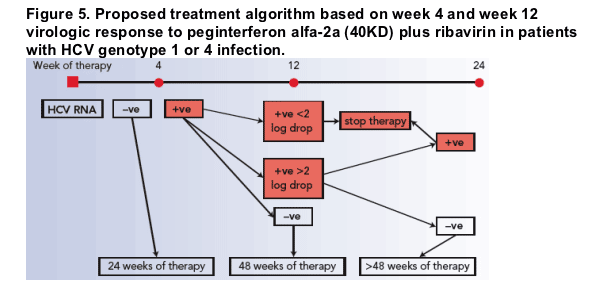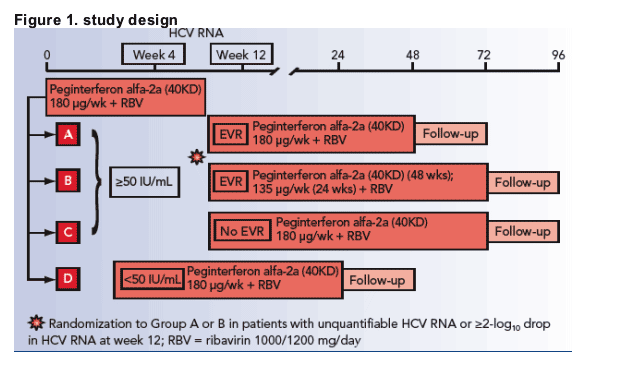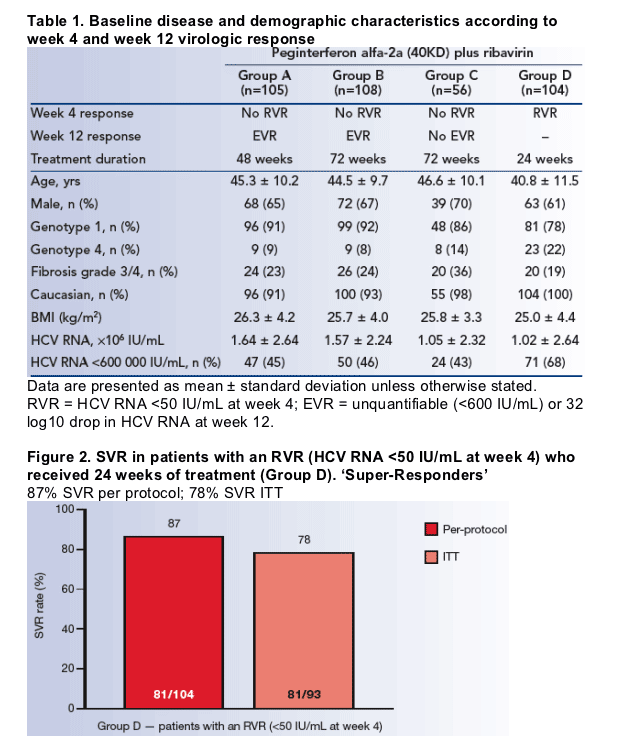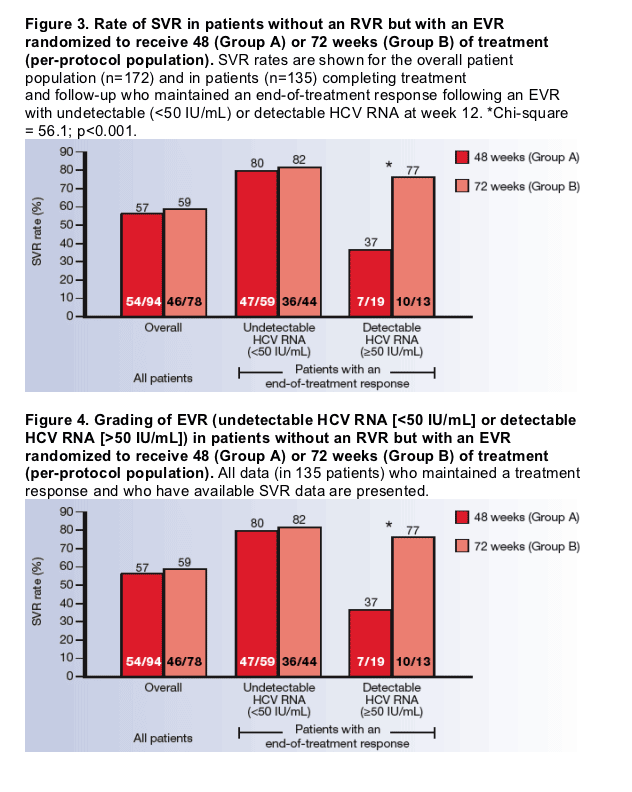 |
 |
 |
| |
72 Weeks Pegasys/RBV in Genotype 1 Improves SVR Rate For Patients With Early Viral Response (2 log reduction at wk 12) But HCV RNA >50 IU/mL
|
| |
| |
Reported by Jules Levin
AASLD, Oct 27-31, 2006, Boston, MA
"Customizing treatment with peginterferon alfa-2a (40KD) (PEGASYS) plus ribavirin (COPEGUS) in patients with HCV genotype 1 or 4 infection: interim results of a prospective randomized trial"
P. Ferenci,1 H. Laferl,2 T-M. Scherzer,1 A. Maieron,3 M. Gschwantler,4 H. Brunner,5 R. Hubmann,6 M. Bischof,7 K. Staufer,1 C. Datz,8 P. Steindl-Munda,1 H. Kessler9
1Medical University of Vienna, Vienna, Austria; 2Kaiser Franz Josef Hospital, Vienna, Austria; 3Krankenhaus der Elisabethinnen, Linz, Austria; 4Wilhelminenhospital, Vienna, Austria; 5Krankenhaus Lainz, Vienna, Austria; 6General Hospital, Linz, Austria;
7Krankenhaus Rudolfstiftung, Vienna, Austria; 8Krankenhaus Oberndorf, Oberndorf, Austria; 9Medical University of Graz, Graz, Austria
Treatment algorithm
(proposed by study authors, based on results. This algorithm makes much sense.)
Based on these findings a treatment algorithm for patients with HCV genotype 1 or 4 infection is proposed, derived from 'on-treatment' virologic response at weeks 4 and 12 (Figure 5).
- patients with an RVR should be treated for 24 weeks
- patients without an RVR but who have HCV RNA levels <50 IU/mL at week 12 should be treated for 48 weeks
- patients with an EVR but with HCV RNA >50 IU/mL at week 12 could benefit from a longer treatment duration of 72 weeks
- consistent with treatment guidelines,[1] patients without an EVR should not continue treatment as the likelihood of achieving an SVR is minimal (<5%).

INTRODUCTION
The recommended treatment for patients infected with hepatitis C virus (HCV) genotypes 1 and 4 is a pegylated interferon plus ribavirin 1000 or 1200 mg/day for 48 weeks.[1] Sustained virologic response (SVR) rates of up to 60% have been seen in patients with HCV genotype 1 infection treated with peginterferon alfa-2a (40KD) (PEGASYS) plus ribavirin (COPEGUS),[2-4] and efforts to optimize and improve therapeutic outcomes are ongoing. Rapid virologic
response (RVR) after 4 weeks of treatment and early virologic response (EVR) after 12 weeks of treatment play an important role in customization of therapy and have been shown to be strong predictors of response.[5-7]
Patients with HCV genotype 1 infection who achieve an RVR have a high chance of achieving an SVR after just 24 weeks of treatment with peginterferon alfa-2a (40KD) plus ribavirin 1000/1200 mg/day.[6,7] Conversely, patients with HCV genotype 1 who fail to achieve an RVR may be considered 'difficult-to-cure', and some of these patients may benefit from an extended duration of treatment.[8]
Current treatment guidelines state that patients with HCV genotype 1 who fail to achieve an EVR have only a small chance of going on to achieve an SVR, and so therapy should be stopped at this time in these patients.[1] Patients who achieve an EVR and who have undetectable HCV RNA have an excellent chance of going on to achieve an SVR with a standard duration of treatment of 48 weeks.[5] Additional studies have shown that patients with HCV genotype 1
who achieve an EVR, but who have HCV RNA between 50-600 IU/mL may also benefit from an extension of treatment with peginterferon alfa-2a (40KD) plus ribavirin.[9]
In this prospective study we investigated the customization of peginterferon alfa-2a (40KD) plus ribavirin treatment duration in patients with HCV genotype 1 or 4 infection based on virologic response at weeks 4 and 12 of treatment.
CONCLUSIONS
This interim analysis supports the concept of customization of therapy based on an RVR and an EVR. Patients with HCV genotype 1 or 4 infection who achieved an RVR with peginterferon alfa-2a (40KD) (PEGASYS) plus ribavirin (COPEGUS) were successfully treated (SVR rate of 87%) with a shortened duration (24 weeks) of therapy. Overall, patients who did not achieve an RVR but who achieved an EVR gained minimum additional benefit with an extended duration of therapy.
Patients who achieved an EVR with HCV RNA levels <50 IU/mL at week 12 achieved an excellent rate of SVR (80%) with a standard duration of therapy of 48 weeks. This response rate was identical to the response achieved in the Berg study,[9] which showed that a 48-week duration of treatment with peginterferon alfa-2a (40KD) and only 800 mg ribavirin resulted in an SVR rate of 80% in patients with HCV genotype 1 and HCV RNA <50 IU/mL at week 12. The data from the analysis presented here is also consistent with data from an earlier analysis[5] of the phase III study published by Fried et al.,[3] which shows that patients treated with 48 weeks of peginterferon alfa-2a (40KD) plus ribavirin 1000/1200 mg who achieved HCV RNA suppression <50 IU/mL had an SVR rate of 78%.
In contrast, in a subgroup of patients who had an EVR but who had incomplete viral suppression (HCV RNA 350 IU/mL) at week 12, a longer treatment duration of 72 weeks was significantly (p<0.001) beneficial compared with the standard 48-week treatment duration (SVR rates of 37% vs 77%, respectively). These data are consistent with the recently published data by Berg et al,[9] indicating that patients with HCV RNA 350 IU/mL at week 12 benefited from a 24-week treatment extension. In the Berg study, SVR rates of 29% were achieved with 72 weeks of therapy with peginterferon alfa-2a plus ribavirin, compared with 17% achieved with 48 weeks of therapy (p=0.040), in patients who were HCV RNA positive at week 12. It should be noted that the findings of Berg et al. are for the intent-to-treat patient population, while our results refer only to those patients in the per-protocol population with an end-of-treatment response. Patients who do not achieve an EVR are unlikely to respond even with 72 weeks of treatment,
which confirms the established EVR-based guidelines.
Customization of peginterferon alfa-2a (40KD) plus ribavirin therapy based on week 4 and week 12 virologic response is therefore a promising approach for the future treatment of HCV patients. The proposed treatment algorithm should be prospectively investigated.
METHODS
Patients
Patients were treatment naive, and aged 18-65 years with hepatitis C genotype 1 or 4 infection. All patients had quantifiable HCV RNA by polymerase chain reaction (PCR) assay (COBAS AMPLICOR HCV MONITOR Test, v2.0, limit of quantitation 600 IU/mL), elevated serum alanine aminotransferase levels, a liver biopsy performed within 6 months consistent with a diagnosis of chronic hepatitis C and compensated liver disease.
Study design
The study design is presented in Figure 1.
Patients were initially treated with peginterferon alfa-2a (40KD) 180 _g/week plus ribavirin 1000/1200 mg/day.
At week 4, HCV RNA levels were tested in all patients. Patients with an RVR, defined as undetectable HCV RNA by PCR assay (COBAS AMPLICOR HCV Test, v2.0, limit of detection 50 IU/mL), were assigned to a shortened duration (24 weeks) of therapy (Group D).
Patients without an RVR continued to receive therapy, and HCV RNA level was retested at week 12.

Patients with an EVR, defined as unquantifiable HCV RNA (COBAS AMPLICOR HCV MONITOR Test, v2.0, limit of quantitation 600 IU/mL) or >2-log10 drop in HCV RNA at week 12, were randomized to 48 weeks (Group A) or 72 weeks (Group B) of therapy.
- the HCV RNA level of patients with an EVR was retrospectively assessed using
COBAS AMPLICOR HCV Test, v2.0, limit of detection 50 IU/mL.
All remaining patients (without an RVR and without an EVR) were assigned to Group C and treated for 72 weeks.
At week 24, therapy was terminated if HCV RNA remained detectable (HCV RNA >50 IU/mL) in Groups A to C.
Assessments and end-points
The primary efficacy end-point in this study was SVR, defined as undetectable HCV RNA at 24 weeks after the end of treatment.
End-of-treatment response rates, defined as undetectable HCV RNA at the end of the treatment period, for arms A and B of the study were also assessed.
SVR rates were calculated for the per-protocol and the intent-to-treat (ITT) patient populations.
- the per-protocol population analysis is appropriate in studies comparing treatment durations as this analysis will avoid potential bias in favor of the shorter duration of treatment, which may be introduced by premature withdrawal of patients from the 72-week treatment arm.
On-treatment virologic assessments at weeks 4, 12 and 24 were also conducted as described in the study design.
Statistical analysis
The study was designed to achieve a statistical power of 80% with a 2-sided significance level of 5% based on the two randomized treatment arms (Groups A and B).
- a total sample size of 242 patients was calculated to be sufficient to detect a difference of 15% in relapse rates between groups A and B
- using an assumption that 78% of patients who initiate treatment will achieve a response at the end of treatment, we recruited 312 patients into Groups A and B
- the study was initially designed to recruit 444 patients in total.
A much higher proportion (28%) of patients achieved an RVR with peginterferon alfa-2a (40KD) plus ribavirin than was estimated at the start of the study (12%).
- as these patients entered treatment Group D, in order to maintain the power of the study (with 312 patients randomized to groups A and B) recruitment was increased to at least 565 patients.
The study is now fully recruited, with 570 patients screened. The data presented here are based on an interim analysis of 400 patients included in the study to June 30, 2005 (the prospectively defined analysis point of patients receiving a 24-week duration of treatment [Group D]).
- in this interim analysis, all available data are presented
- a subset analysis was retrospectively performed in patients without an RVR but who had an EVR (and were randomized to either group A or B), and who maintained a response to the end of treatment (HCV RNA <50 IU/mL)
- SVR and end-of-treatment responses for these patients were stratified based on the EVR response of the patient (either undetectable HCV RNA [<50 IU/mL] or detectable HCV RNA [>50 IU/mL]) and were compared using chi-square analysis.
RESULTS
Patient characteristics
Patient (n=373) demographic and disease characteristics are summarized in Table 1.
Patients with an RVR (Group D) had baseline characteristics that were representative of an 'easier-to-treat' population compared with the other three treatment groups.
- a larger proportion of patients had a baseline HCV RNA level below 600 000 IU/mL, fewer patients had fibrosis grade 3/4, and patients were more likely to be infected with HCV genotype 4.
Patients without an RVR but with an EVR (Groups A and B) had similar baseline characteristics.
Patients without an RVR and without an EVR (Group C) showed a trend towards more 'difficult-to-treat' characteristics.
- 57% of patients had a baseline HCV RNA level greater than 600 000 IU/mL and 36% of patients had fibrosis grade 3/4.
Outcome in patients with an RVR
87% of HCV genotype 1 and 4 patients who achieved an RVR with peginterferon alfa-2a (40KD) plus ribavirin therapy subsequently achieved an SVR following 24 weeks of therapy (Figure 2).
These data have been previously presented.[10,11]
- using an ITT analysis, the rate of SVR was 78% (Figure 2).

Outcome in patients without an RVR but with an EVR
Similar SVR rates were observed in patients without an RVR but with an EVR who received 48 and 72 weeks of treatment (57% and 59% in Groups A and B, respectively; Figure 3).
- at the end of treatment, responses to therapy (HCV RNA <50 IU/mL) were seen in 84% (85/101) and 76% (66/87) of patients in Groups A and B, respectively.
In the subset of patients in groups A and B who maintained their response from 12 weeks (EVR) through to the end of treatment (HCV RNA <50 IU/mL), SVR data were available for a total of 135 patients.
- comparison of 48 and 72 weeks of treatment in this subset of patients showed an overall SVR rate of 69% (54/78) 48 weeks of treatment (Group A) and 81% (46/57) patients treated for 72 weeks (Group B).
The SVR and end-of-treatment data from the subset of 135 patients were retrospectively stratified according to the EVR achieved by the patient (HCV RNA undetectable [<50 IU/mL] or HCV RNA detectable [>50 IU/mL]).
- of these, 103 patients had an EVR graded as HCV RNA undetectable (<50 IU/mL) and 32 patients had an EVR but had detectable HCV RNA (350 IU/mL) (Figure 4)
- SVR rates for patients with undetectable HCV RNA (<50 IU/mL) at week 12 were similar between 48 and 72 weeks of treatment (80% and 82%, respectively) (Figure 3)
- in contrast, in patients with an EVR but with detectable HCV RNA (>50 IU/mL), SVR rates were greater in the patients who were treated for 72 weeks, than for the patients who were treated for 48 weeks (77% vs 37%) (Figure 3)
- patients in Group A treated for 48 weeks who had detectable HCV RNA thus experienced higher rates of relapse than patients in group B treated for 72 weeks (Table 2).


Outcome in patients without an RVR and an EVR
An extension of therapy to 72 weeks in patients without an RVR and an EVR (Group C) provided an SVR to just 4% of patients.
- this confirms the clinical utility of EVR as an evaluation point for continuing or
discontinuing treatment.
REFERENCES
1. NIH Consensus Statement on Management of Hepatitis C: 2002. NIH Consens State Sci Statements 2002; 19 (3): 1-46
2. Fried MW, Shiffman ML, Reddy KR, et al. Peginterferon alfa-2a plus ribavirin for chronic hepatitis C virus infection. N Engl J Med 2002; 347 (13): 975-82
3. Hadziyannis S, Sette H, Morgan T, et al. Peginterferon-alpha2a and ribavirin combination therapy in chronic hepatitis C: a randomized study of treatment duration and ribavirin dose. Ann Intern Med 2004; 140 (5): 346-55
4. Zeuzem S, Pawlotsky JM, Lukasiewicz E, et al. International, multicenter, randomized, controlled study comparing dynamically individualized versus standard treatment in patients with chronic hepatitis C. J Hepatol 2005; 43(2): 250-7
5. Ferenci P, Fried MW, Shiffman ML, et al. Predicting sustained virological responses in chronic hepatitis C patients treated with peginterferon alfa-2a (40 KD)/ribavirin. J Hepatol 2005; 43 (3): 425-33
6. Jensen DM, Morgan TR, Marcellin P, et al. Early identification of HCV genotype 1 patients responding to 24 weeks peginterferon alpha-2a (40 kd)/ribavirin therapy. Hepatology 2006; 43 (5): 954-60
7. Zeuzem S, Buti M, Ferenci P, et al. Efficacy of 24 weeks treatment with peginterferon alfa-2b plus ribavirin in patients with chronic hepatitis C infected with genotype 1 and low pretreatment viremia. J Hepatol 2006; 44 (1): 97-103
8. Sanchez-Tapias JM, Diago M, Escartin P, et al. Peginterferon-alfa2a plus ribavirin for 48 versus 72 weeks in patients with detectable hepatitis C virus RNA at week 4 of treatment. Gastroenterology 2006; 131 (2): 451-60
9. Berg T, von Wagner M, Nasser S, et al. Extended treatment duration for hepatitis C virus type 1: comparing 48 versus 72 weeks of peginterferon-alfa-2a plus ribavirin. Gastroenterology 2006; 130 (4): 1086-97
10. Ferenci P, Bergholz U, Laferl H, et al. 24 week treatment regimen with peginterferon alfa-2a (40KD) (PEGASYS) plus ribavirin (COPEGUS) in HCV genotype 1 or 4 'super-responders'. J Hepatol 2006; 44: S6
11. Ferenci P, Bischof M, Stauber R, et al. Is shorter treatment with peginterferon alfa-2a (40KD) (PEGASYS) plus ribavirin (COPEGUS) possible in HCV genotype 1 'super-responders'? Preliminary results of a prospective randomized clinical trial. Hepatology 2005; 42(Suppl. 1): 218A
|
| |
|
 |
 |
|
|